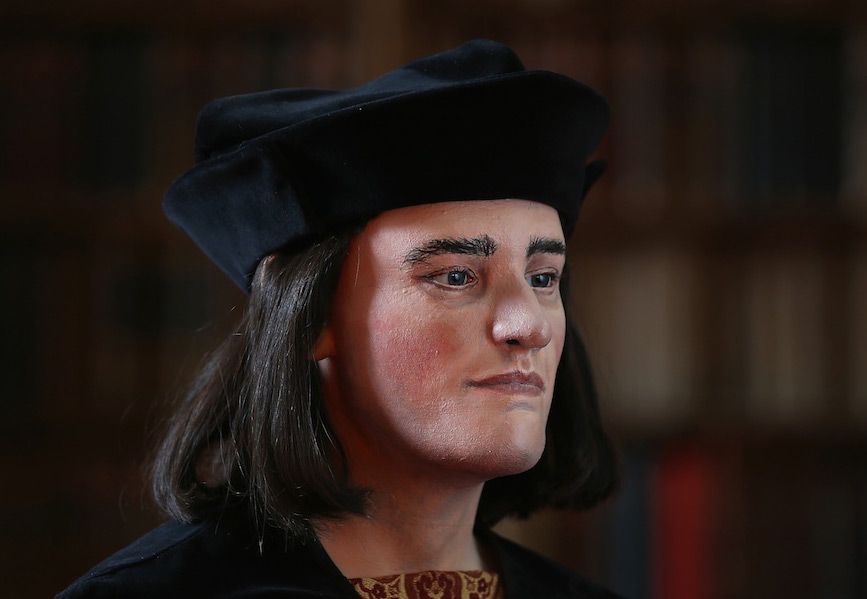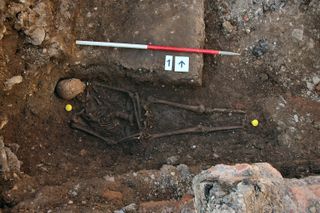Emotion Behind Richard III Search Revealed in New Documentary

A new documentary about King Richard III reveals the twists and turns of the discovery of his bones — from the unveiling of the royal leg bones on the first day of digging to the forensic reconstruction of the king's face.
"The King's Skeleton: Richard III Revealed," set to air Sunday (April 21) on the Smithsonian Channel, is the only documentary with behind-the-scenes access to the dig and analysis as it was happening, lending the production a more urgent, emotional feel than many of the news reports about the discovery.
"It's been a complete roller-coaster ride," Philippa Langley, a screenwriter and member of the Richard III Society who spearheaded the search for the English king, told the documentary crew. [Gallery: Search for the Grave of Richard III]
A lost king
Researchers at the University of Leicester in England announced in February that they'd discovered the remains of the medieval king "beyond reasonable doubt." The team began digging for the king in August at the urging of Langley, who raised funds, partnered with historians to find the best spot to dig, and in many cases cajoled and begged scientists to get on board, she said.

"It seemed utterly bonkers," said Leon Hunt, a dig supervisor on the university team. "One of the things you don't do in archaeology is you don't go looking for a specific thing, because chances are you'll never find it."
Richard III ruled England from 1483 to 1485, after his brother Edward V's death. Richard's rise to the throne is shrouded in controversy. His two young nephews, who had a claim on the crown before him, disappeared from the Tower of London shortly before Richard was crowned, leading to speculation that he may have had them killed.
Sign up for the Live Science daily newsletter now
Get the world’s most fascinating discoveries delivered straight to your inbox.
In 1485, Richard III died in the War of the Roses at the Battle of Bosworth Field. He was reportedly buried in Leicester, though rumors started centuries later held that his body was dumped in a river. After his death, Richard was further demonized by the Tudor dynasty, which needed to denigrate the old king to cement its power. A century later, William Shakespeare's play "Richard III" set the king's legacy as a villain.
Langley and the historians with whom she spoke didn't believe those tales, or the ones about the undignified river burial. Most likely, they determined, Richard III was buried at the Leicester Franciscan friary, known as Greyfriars.
Found in a parking lot
Langley got the University of Leicester on board for a search for the lost Greyfriars church in a city council parking lot. As the new Smithsonian documentary reveals, archaeologists expected to dig a few trenches, excavate some friary buildings and ideally learn a bit about the church layout.
Instead, on day one, they found leg bones.
They quickly re-covered the bones for later analysis, not knowing whether the remains were inside the church walls (where Richard III would be interred). But by day 13 of the dig, they'd determined that the bones were, in fact, in the church. What's more, the skeleton they uncovered had skull wounds and a twisted spine, consistent with historical depictions of Richard III as a hunchback.
Followers of the news may know where the documentary is headed as the subject turns to proving the bones are really Richard's. But the walk through the process is fascinating, especially as Langley and other members of the search team respond to each new discovery in real time. There are even hints at the difficulties of interpreting an archaeological scene: A bit of metal, first thought to be an arrowhead embedded in the king's spine, turns out to be something quite unexpected. As the evidence stacks up, however, the king's identity only becomes clearer.
"The King's Skeleton: Richard III Revealed" will air on the Smithsonian Channel on Sunday (April 21) at 9 p.m. EDT/PDT.
Follow Stephanie Pappas on Twitter and Google+. Follow us @livescience, Facebook & Google+. Original article on LiveScience.com.

Stephanie Pappas is a contributing writer for Live Science, covering topics ranging from geoscience to archaeology to the human brain and behavior. She was previously a senior writer for Live Science but is now a freelancer based in Denver, Colorado, and regularly contributes to Scientific American and The Monitor, the monthly magazine of the American Psychological Association. Stephanie received a bachelor's degree in psychology from the University of South Carolina and a graduate certificate in science communication from the University of California, Santa Cruz.











